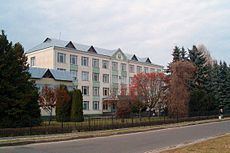First mentioned 1445 Population 13,390 (2011) | Magdeburg law 1584 Local time Friday 4:47 PM | |
 | ||
Weather 6°C, Wind W at 18 km/h, 70% Humidity | ||
Berezne (Ukrainian: Березне, Russian: Берёзно, Polish: Bereźne) is a city in Rivne Oblast, Ukraine, located on the Sluch River north of Rivne. It is the administrative centre of the Berezne Raion. Population is 13,390 (2011)
Contents
Map of Berezne, Rivne Oblast, Ukraine
History
Berezne was established in 1445 within the Polish-Lithuanian Commonwealth. Since the Union of Lublin the town was part of the Kingdom of Poland, where it remained until the Partitions of Poland. Annexed by the Russian Empire, Berezne in 1919 returned to Poland. In the Second Polish Republic it was a garrison of the Berezne Battalion of the Border Protection Corps. Until 1939, Berezne belonged to Kostopol County, Volhynian Voivodeship.
In 1943, during the Volhynian Genocide, 96 ethnic Poles of Berezne were murdered by Ukrainian nationalists of the Ukrainian Insurgent Army. The first attack on the town took place in June 1943. Other attacks occurred in the second half of that year, and as a result Polish survivors fled to larger towns, such as Rowne. In June 1945 the remaining Poles were forced to leave Berezne.
Jews of Berezne
The majority of the population in the area has always been Ukrainian. However, it is notable that substantial minority populations of Poles and Jews have lived there as well. Rule over the area changed hands between the Poles and the Russians over the centuries, culminating with Ukrainian independence after the breakup of the Soviet Union. Starting in the mid-17th century resentment of the Ukrainian population grew over the presence of what they considered foreigners in their midst; and demagogues, starting with Bogdan Chmelnitsky, used this to fan the flames of nationalism. Chmelnitsky initiated bloody pogroms against thousands of Jews in Ukraine. Unfortunately the Jews of Berezne did not escape this particularly vicious manifestation of nationalism which took many innocent lives.
World War II
During World War II many Ukrainians saw the war not only as an opportunity to rid themselves of Soviet rule, but also to create a pure Ukrainian state by ridding themselves of people whom they felt did not belong there, such as Jews and Poles. In 1941 the German Wehrmacht entered the town as part of the Barbarossa operation. Immediately all the houses of the Jews were burnt and the Jews were left with no possessions but their own clothes.
The Jews of Berezne, who then numbered approximately 3000, were forced to live in three small buildings surrounded by walls. This contained area became known as the local ghetto.
In the following year the Ukrainians, together with the Germans, used Jews for slave labor, and hardly any food was supplied for them. The Jews were forced to work at hard jobs in the forest without compensation, and were frequently beaten. (Some of these Jews escaped into the woods to survive, and related accounts of the slave labor and beatings.)
SS
In August 1942 the SS special Einzatzgruppen unit entered the town. Immediately the Jews received even more severe beatings. Three days later all Jews that could be found were taken from the ghetto into the woods, where they were forced to dig a huge hole. These Jews were later shot and buried at this location.
Many of the Jews that escaped into the woods next to Berezne were turned in to the Germans by local Ukrainians, who aided the SS in the process of genocide now known as "ethnic cleansing".
Survivors
Only a few hundred of the Jews of Berezne survived. Most of these either hid next to Mazorish (Polish) villages that gave them food in return for firewood used for heating, or left the area along with the Communists, before the Nazis entered. For many years there stood a monument memorializing the over 3000 men, women, and children who were slaughtered by the Nazis and local Ukrainian collaborators, at the site of their mass grave. Corresponding to common Soviet practice, the Soviet authorities refused to mention on the monument that the 3680 murdered victims were Jews, instead describing them as "citizens of the Soviet Union".
